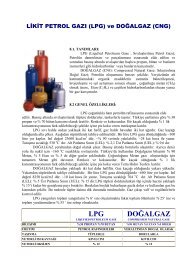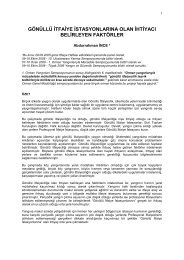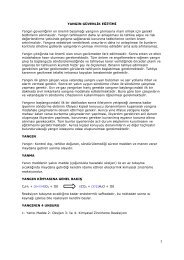buradan - Yangın
buradan - Yangın
buradan - Yangın
Create successful ePaper yourself
Turn your PDF publications into a flip-book with our unique Google optimized e-Paper software.
toxic. The CO content was reported to raise quickly over 150 ppm<br />
within minutes. More than 1000 ppm will cause death.<br />
The fire quickly spread to the vehicles behind the truck and all<br />
passengers travelling in those 25 vehicles died.<br />
It was believed that the fast growth of the fire was due to the large<br />
fuel load of the truck including:<br />
w 550 litres of diesel in the truck’s fuel tank<br />
w 9 tons of margarine and 12 tons of flour carried by the truck<br />
w The shell of the refrigerated trailer made of a combustible<br />
isothermal foam<br />
Different ventilation regimes between France and Italy sides were<br />
set in the tunnel and most smoke was driven to the France side<br />
(evacuation side). Due to the airflow velocity (1 to 1.5 m/s) smoke<br />
was not stratified filling the whole section of the tunnel.<br />
The fire burned for two days and reached temperatures of 1000°C,<br />
killing 39 people, mainly the drivers trapped in the tunnel during<br />
the fire.<br />
Since tunnel opening in 1965 seventeen additional fires have occur<br />
in the Mont Blanc Tunnel.<br />
Tauern:6.4 km long, Austria, 1999<br />
On 20 of May 1999 HGV collided and a large fire spread through<br />
the Tauern road tunnel in Austria. As a result of the fire 12 people<br />
died, 22 cars and 12 lorries were totally destroyed, and parts of the<br />
tunnel caved in.<br />
Local fire and rescue service brigades attempted to extinguish the<br />
fire in the tunnel at an early stage of the operation, but were not<br />
successful and had instead to break off the operation when the<br />
working conditions became too difficult. They had to concentrate<br />
on taking care of the injured and others effected.<br />
The tunnel has a number of safety systems, but none of these<br />
could do anything to save the people in the tunnel or to extinguish<br />
the fire. The quick spread of the fire and the high fire load of the<br />
stationary vehicles, meant that many people were still in the tunnel,<br />
and also that it was extremely difficult for the fire and rescue service<br />
to attempt to rescue them or to extinguish the fire.<br />
Besides lost of lives this major fire cost 6.5 M$ to repair and 19.5<br />
M$ toll lost.<br />
Three additional fires have been recorded in Tauern Tunnel.<br />
Main lessons learned from these major accidents were:<br />
w Ventilation regimes play a crucial role to prevent fire growth and<br />
to drive smoke into the direction that guarantees evacuation.<br />
w Safety systems consist of a whole system of planned measures<br />
that operate together.<br />
w There are many different possible scenarios in these incidents<br />
and low knowledge on the effect of different parameters<br />
(ventilation, tunnel section size, tunnel length, combustibles, …)<br />
on fire development.<br />
Table 1. UPTUN results<br />
Risk to life<br />
HRR MW<br />
Risk to construction<br />
Road,<br />
examples<br />
vehicles<br />
Rail<br />
examples<br />
vehicles<br />
BİLDİRİLER KİTABI TÜYAK<br />
PROCEEDINGS BOOK 2009<br />
Metro,<br />
examples<br />
vehicles<br />
w Fire fighting systems installed in the tunnel bay that time<br />
didn’t help fire brigades task. Conditions in the tunnel became<br />
untenable.<br />
During last years several projects have been launched by<br />
Administrations in order to better understand hazard and to<br />
evaluate different solutions and strategies to improve safety in<br />
tunnels. Special mention to the UPTUN<br />
2. Low Pressure Water Mist System<br />
Water mist system tested is a low pressure water mist solution<br />
designed to be used with plain water. Proposed solution is offered<br />
and supplied by modules in order to reduce cost and installation<br />
time. Two types of modules, primary modules or activation modules<br />
and secondary modules, are supplied; each module is 10 meter<br />
long. See Figure 1.<br />
TÜYAK 2009<br />
At the fire<br />
boundary<br />
5 1-2 cars ISO 834<br />
10<br />
20<br />
30<br />
50<br />
70<br />
100<br />
150<br />
200 or<br />
higher<br />
Small van,<br />
3-3 cars ++<br />
Big van,<br />
public bus.<br />
multiple<br />
vehicles<br />
Bus, empty<br />
HGV<br />
Combustibles<br />
load on truck<br />
HGV<br />
load with<br />
combustibles<br />
(approx 4<br />
tonne)<br />
HGV<br />
(average)<br />
Loaded with<br />
easy comb<br />
HGV (approx<br />
10 tons)<br />
Limited by<br />
oxygen,<br />
petrol tanker,<br />
multiple<br />
HGVs<br />
Electric<br />
locomotive<br />
passengers<br />
carriage<br />
Open<br />
freight<br />
wagons<br />
with lorries<br />
limited<br />
oxygen<br />
Figure 1. Low pressure water mist system<br />
Low<br />
combustible<br />
passengers<br />
carriage<br />
Normal<br />
combustble<br />
pessengers<br />
carriage<br />
Two<br />
Carriages<br />
Multiple<br />
carriages<br />
(more that<br />
two)<br />
ISO 834<br />
ISO 834<br />
ISO 834<br />
ISO 834<br />
HC<br />
HC<br />
RWS<br />
RWS<br />
3





